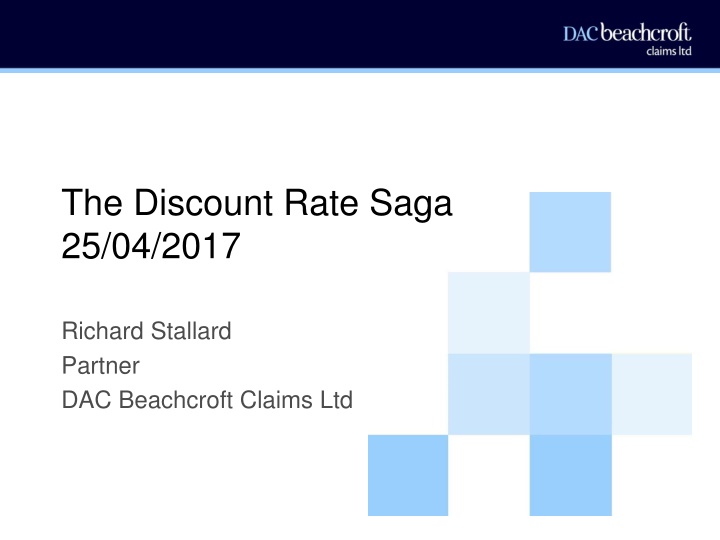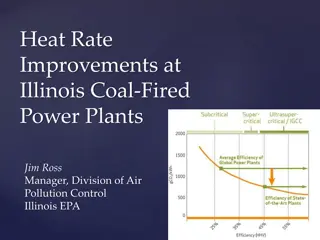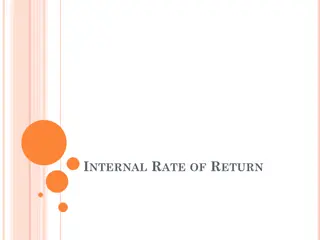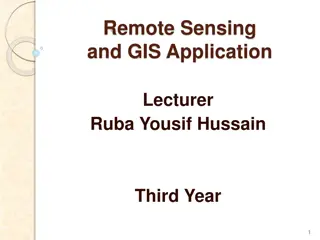
The Discount Rate Saga in Legal Claims
Explore the history and significance of the discount rate in legal claims through a detailed account of how it evolved, its impact on claimants, and the challenges in setting the rate. Learn about the implications for both parties involved and the potential outcomes in the legal landscape.
Download Presentation

Please find below an Image/Link to download the presentation.
The content on the website is provided AS IS for your information and personal use only. It may not be sold, licensed, or shared on other websites without obtaining consent from the author. If you encounter any issues during the download, it is possible that the publisher has removed the file from their server.
You are allowed to download the files provided on this website for personal or commercial use, subject to the condition that they are used lawfully. All files are the property of their respective owners.
The content on the website is provided AS IS for your information and personal use only. It may not be sold, licensed, or shared on other websites without obtaining consent from the author.
E N D
Presentation Transcript
The Discount Rate Saga 25/04/2017 Richard Stallard Partner DAC Beachcroft Claims Ltd
Areas to be covered How we got here; a brief history of the discount rate The new numbers; how crazy is 'crazy' The current methodology for setting the rate Why investment in ILGs is not a virtually risk-free strategy What Claimants do invest in The accommodation claim conundrum. The impact on PPOs The consultation paper on how to set the rate What's happening in the meantime What the outcome might be
What is the discount rate? The assumed net rate of return on investing damages or (now) the assumed loss on investing damages Note: this is the real rate of return (or loss) so is after inflation, tax, investment advice
How we got here before Wells Courts approach; 4 to 5% based on return on mixed portfolio of equities and gilts Then: ILGs first issued by UK Government 1981 1stEdition of Ogden Tables 1984 Law Commission Report on Structured Settlements and Interim and Provisional Damages Damages Act 1994 1996
How we got here Wells v Wells 1998 Full compensation, no more no less Claimants are to be treated as a special category of investor ILGs are the most accurate way of calculating the loss which Claimants suffer in real terms What Claimants actually invest in is irrelevant as is the practice of the Court of Protection Rate set at 3%
How we got here after Wells; the Lord Chancellor s (in)action Lord Chancellor's Order Rate set at 2.5% 2001 Lord Chancellor announces review 2010 MoJ's 1stConsultation No response, no change 2012 MoJ's 2ndConsultation No response, no change 2013 Panel of experts appointed No report pub'd, no change 2014
How we got here after Wells; the UK Courts Biesheuvel v Birrell High tax rate 1999 Enh d Oudenhoven v Griffin Inns High tax rate 3.0% 2000 Warren v Northern General Hospital Warriner v Warriner High tax rate 3.0% 2000 Long life expectancy/ flawed methodology of LC Growth of care costs 2.5% 2002 Cooke v United Bristol Healthcare Harries v Stevenson 2.5% 2004 Unavailability of PPO 2.5% 2012 Tortolano v Ogilvie Construction Change in economic circumstances CICS claim 2.5% 2013 LHS v First Tier Tribunal 2.5% 2015
How we got here after Wells; the Courts elsewhere Guernsey Privy Council 0.5% for non-earnings related -1.5% for earnings related 2012 Hong Kong Ct of Appeal 2.5% for >10 years 1.0% for 5 10 years -0.5% for <5 years 2014 Bermuda Supreme Court -0.5% to 0% for non ER -2.5% to -1.5% for ER 2015 Ireland Ct of Appeal 1.5% for other losses 1.0% for care 2015
How we got here after Wells; the lead up to the change APIL threatened judicial review 07/10/2016 LC undertook to announce result of review by 31/01/2017 06/12/2016 ABI applied for JR of decision to announce & interim relief 19/12/2016 ABI's application for permission to apply dismissed 20/01/2017 ABI's application for permission to appeal dismissed 26/01/2017 LC postponed announcement to February 27/01/2017 LC announced that rate would reduce to -0.75% w.e.f. 20/03/2017 plus review of framework for setting rate 27/02/2017
The new numbers; how crazy is 'crazy' Age 2.5% DR 35.41 -0.75% DR 128.73 % 100,000 @ 2.5% 3,541,000 100,000 @ -0.75% 12,873,000 increase 364% increase 9,332,000 0 10 34.08 108.32 318% 3,408,000 10,832,000 7,424,000 20 32.10 88.96 277% 3,210,000 8,896,000 5,686,000 30 29.60 71.43 241% 2,960,000 7,143,000 4,183,000 40 26.52 55.66 210% 2,652,000 5,566,000 2,914,000 50 22.69 41.44 183% 2,269,000 4,144,000 1,875,000 60 18.30 29.19 160% 1,830,000 2,919,000 1,089,000 70 13.44 18.85 140% 1,344,000 1,885,000 541,000
The new numbers; how crazy is 'crazy' 140.00 120.00 Male 2.50% Male - 0.75% Female 2.5% Female - 0.75% 100.00 80.00 60.00 40.00 20.00 0.00 0 10 20 30 40 50 60 70 80 90 100 Claimant Age
The current methodology for setting the rate reasons given by Lord Chancellor Full compensation no more, no less Investment of award should be risk free with money being available to meet needs as they arise and with no loss due to inflation This is best achieved by 100% investment in ILGs which attract the lowest level of investment risk and inflation risk The risks associated with ILGs (in not being able to meet needs as they arise meet needs as they arise) can be addressed by effective management and are outweighed by the risks associated with a mixed portfolio A faithful application of the principles in Wells v Wells leads to the 100% ILGs approach as the best way
The current methodology for setting the rate principles referred to in Consultation Paper Full compensation no more, no less Award should be sufficient to meet losses as they arise without shortfall Award should be exhausted at the end of period of loss Claimants should be treated as being very risk averse and investing cautiously which led to the rate being based on investment in ILGs
The current methodology for setting the rate application of principles Single rate for all cases for simplicity Based on simple average of real yields on maturity of all ILGs over the last 3 years to 30/12/2016 excluding ILGs with maturities of less than 5 years rounded up to the nearest 0.25% without allowing for tax, and without allowing for investment charges
Why investment in ILGs is not a virtually risk-free strategy ILGs are a relatively safe investment But investment in a single asset class is never risk-free And this is not a risk-free method of meeting needs as and when they arise due to: The mortality risk The inflation risks The investment risks
Why investment in ILGs is not a virtually risk-free strategy
What Claimants do invest in Not ILGs to maturity A mixed portfolio to spread and lower the risks Make up of portfolio does vary from advisor to advisor, e.g. Specialist personal injury IFAs, other IFAs, investment managers
What Claimants do invest in WMA Private Investor Conservative Index
What Claimants do invest in WMA Private Investor Conservative Index
What Claimants do invest in 7IM Personal Injury Fund
What Claimants do invest in 7IM Personal Injury Fund
The accommodation claim conundrum What claims consist of: Adaptation costs Moving costs Loss of use of capital Additional running costs
The accommodation claim conundrum loss of use of capital C lives in house worth 200,000, needs house costing 350,000, has agreed life expectancy of 10 years Before reduction in DR: 150,000 x 2.5% x 8.86 = 33,225 After reduction in DR: 150,000 x -0.75% x 10.39 = - 11,689
The accommodation claim conundrum The problem: balancing need to fund additional purchase cost with requirement to avoid substantial windfall Potential Solutions: R v J for longer durations Hybrid with capital contribution for shorter durations Rent for short durations Mortgage interest for short durations Interest free loan
The impact on PPOs recent PPO propensity Institute and Faculty of Actuaries provisional results
The impact on PPOs recent PPO propensity Institute and Faculty of Actuaries provisional results
The impact on PPOs factors governing recent PPO propensity Poor performance of ASHE SOC 6115 Better investment returns IFAs willingness to recommend lump sums Insurers' appetite Increasing influence of indemnity limits in EL/PL cases Novelty wearing off
The impact on PPOs % change in carers earnings 2007 to 2016 @ ASHE 6115 80thpercentile 7.00% 6.00% 5.00% 4.00% 3.00% 2.00% 1.00% 0.00% 2007 2008 2009 2010 2011 2012 2013 2014 2015 2016 -1.00% -2.00%
The impact on PPOs comparison of amount of PPs linked to ASHE 6115 and RPI from 2011 to 2015 for initial annual payment of 100,000: ASHE 6115 80th%ile: RPI: 100,495 0.5% increase 115,225 15% increase
The impact on PPOs The natural assumption The reality?
The consultation paper Opened on 30/03 ends on 11/05 Covers England & Wales/Scotland Re-covers some of ground in 2012 & 2013 consultations Committed to 100% principle & that DR should be set by ref to investment returns for assumed risk profile 36 questions covering: Current legal framework Advice Cs receive/decisions make on FoA/investment Availability of PPOs, drivers and implications Assumed risk profile of Claimants Different rates Who should set the rate When the rate should be set
Workshop Single rate/dual rates - pros and cons Who should set the rate? - Minister, panel of experts, combination, other How frequently should the rate be reviewed? - fixed, movement of investment returns Does the law on PPOs need changing?
What's happening in the meantime Review of offers Review of reserves Review of reinsurance position Costs budgeting Claimant s schedules Scrutiny of claims Application of Ogden tables Rehabilitation Counterschedules JSMs Trials
What will the outcome be? Image result for image of question mark
What will the outcome be? The impact of the General Election Legislative change? Single rate/dual rates Applicability Future framework for reviewing rates















